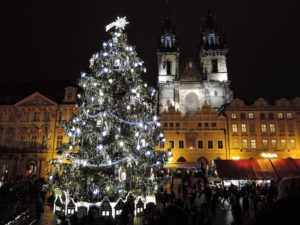Good morning all,
When you hear about Europe in December, chances are that one of the first images that come to mind is that of the huge Christmas markets, isn’t it? And if I ask you to name a few, it’s a safe bet that those in Prague are at the top of your list, as on that of a large majority of us. And for good reason! For several centuries, the first edition dating from at least the Middle Ages, the whole Czech Republic has been beating to the rhythm of the Christmas markets throughout the month of December. In Prague alone, more than 10 markets completely transform the city throughout the month, giving it the appearance of vintage Christmas cards! But what is the connection between that and Learning otherwise, you say? Well, for our Christmas special, we will dwell on the place of such a large cultural event on the education of children!

When tradition punctuates the month of December
Strangely, the Czech Republic is considered the most atheistic country in all of Europe. However, it remains one of the countries most attached to traditional practices inherited from the Christian religion. The paradox takes on its full extent at the beginning of the month, when the arrival of Saint Nicholas on December 5, is highlighted everywhere, from the smallest village to the largest of cities, including schools, and even salons, where family plays are put in place. The arrival of St-Nicolas often coincides with the start of the Christmas markets, which will sometimes remain in place until the beginning of January. Despite the fact that these markets now attract more and more international tourists each year, the Czech Republic, and in particular the city of Prague, takes pride in promoting tradition. Hundreds of kiosks will therefore be filled with traditional Czech products, food, gifts and local arts, and very few kiosks will have imported objects, several markets completely prohibiting them.
These equally important traditions are joined by other equally important traditions: the Christmas choirs, several dozen of them, often made up of children, will storm the various stages of the city in December; exhibitions of more creative nurseries than each other and Pohàdka (Czech fairy tales), which will be read in collections or listened to on radio or television.
But you will have understood that in order to make this happen, year after year, a large part of the population has to get involved, and schools are no exception. Between workshops for making objects and food that will be sold in the markets, practices of the school choir or the Saint-Nicolas show and creation of crèches, children are very involved in these great national traditions. So in what ways is it integrated into the educational program? How, as a teacher, do you stay creative year after year to arouse children’s interest, not to mention the large number of overtime hours associated with all of this! What is the impact of these great traditions on children’s learning? And in the families of craftsmen, how is the knowledge, sometimes ancestral, of parents to children transmitted? These main lines will motivate our filming in Prague!

Traditional Czech education: an education based on social class?
In the Czech Republic, there is no suburb or poor neighborhood. Ghettos are nonexistent. Although there are some richer neighborhoods, the legacy of the communist system which has favored equal rents and the fact that the country receives very few immigrants, has avoided the creation of territorial segregation. However, the Czech school system is often singled out at the international level for its unequal character. Indeed, according to many, social class conditions educational guidance.
David Greger, director of the Institute for Educational Research and Development at the Faculty of Education at Charles University in Prague, explains this fact in these words during an interview he gave in March 2007 to XYZep . The system is mainly based on early selection and orientation. In general, pupils with a “general academic aptitude” are sent to traditional schools, while the others follow courses and special programs. The first selection takes place at the age of eight and the second at eleven. Only 10% of students enter a classical college level (gymnasium) for an eight-year course. ”
Although the defenders of the system affirm that the selection is based on merit and aims to allow children to follow a curriculum that is based on their strengths, it must be admitted that only 7% of students attending gymnasiums come from disadvantaged families while 79% of them come from privileged families.
This selectivity also means that 5% of pupils, those with high special educational needs, are educated separately from the others. However, this category mainly includes students from disadvantaged backgrounds, mainly Roma children, who instead of being helped, will be redirected elsewhere.

Traditional Czech education at a glance
- In the Czech Republic, education is compulsory from 6 to 15 years old and has been since 1774.
- For 0-3 year olds, the school called Jesle is optional, paying as seen as a daycare service, and very little popular these days.
- For 3-6 year olds, nursery schools, also optional, take over. The first 2 years are also paid and considered a daycare service, then the last year, called the pre-primary year, is free. 88% of Czech children will attend these nursery schools.
- Elementary school 1st degree is for children from 6 to 11 years old.
- In PISA assessments, the Czech Republic ranks roughly at the same level as France. On the other hand, when we really look at the results, we realize that they are very different depending on the social origin of the students and especially the schools they attend.
- The official language is Czech, but the Polish minority has its own education system.
This will end the European portion of our trip. We will then take the direction of Asia!
See you next week,
Genevieve